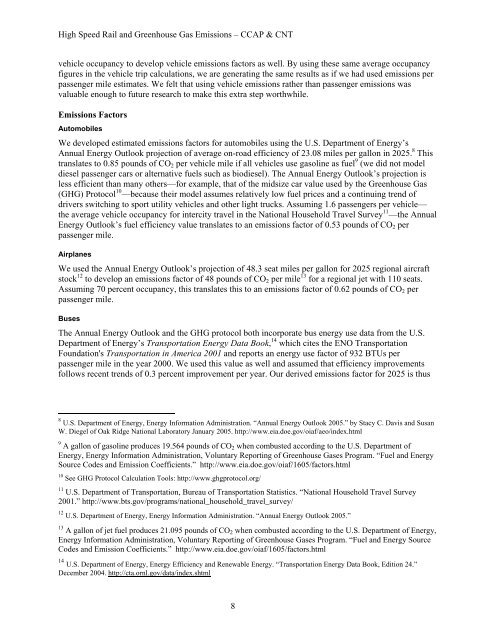High Speed Rail - Center for Neighborhood Technology
High Speed Rail - Center for Neighborhood Technology
High Speed Rail - Center for Neighborhood Technology
You also want an ePaper? Increase the reach of your titles
YUMPU automatically turns print PDFs into web optimized ePapers that Google loves.
<strong>High</strong> <strong>Speed</strong> <strong>Rail</strong> and Greenhouse Gas Emissions – CCAP & CNT<br />
vehicle occupancy to develop vehicle emissions factors as well. By using these same average occupancy<br />
figures in the vehicle trip calculations, we are generating the same results as if we had used emissions per<br />
passenger mile estimates. We felt that using vehicle emissions rather than passenger emissions was<br />
valuable enough to future research to make this extra step worthwhile.<br />
Emissions Factors<br />
Automobiles<br />
We developed estimated emissions factors <strong>for</strong> automobiles using the U.S. Department of Energy’s<br />
Annual Energy Outlook projection of average on-road efficiency of 23.08 miles per gallon in 2025. 8 This<br />
translates to 0.85 pounds of CO2 per vehicle mile if all vehicles use gasoline as fuel 9 (we did not model<br />
diesel passenger cars or alternative fuels such as biodiesel). The Annual Energy Outlook’s projection is<br />
less efficient than many others—<strong>for</strong> example, that of the midsize car value used by the Greenhouse Gas<br />
(GHG) Protocol 10 —because their model assumes relatively low fuel prices and a continuing trend of<br />
drivers switching to sport utility vehicles and other light trucks. Assuming 1.6 passengers per vehicle—<br />
the average vehicle occupancy <strong>for</strong> intercity travel in the National Household Travel Survey 11 —the Annual<br />
Energy Outlook’s fuel efficiency value translates to an emissions factor of 0.53 pounds of CO2 per<br />
passenger mile.<br />
Airplanes<br />
We used the Annual Energy Outlook’s projection of 48.3 seat miles per gallon <strong>for</strong> 2025 regional aircraft<br />
stock 12 to develop an emissions factor of 48 pounds of CO2 per mile 13 <strong>for</strong> a regional jet with 110 seats.<br />
Assuming 70 percent occupancy, this translates this to an emissions factor of 0.62 pounds of CO2 per<br />
passenger mile.<br />
Buses<br />
The Annual Energy Outlook and the GHG protocol both incorporate bus energy use data from the U.S.<br />
Department of Energy’s Transportation Energy Data Book, 14 which cites the ENO Transportation<br />
Foundation's Transportation in America 2001 and reports an energy use factor of 932 BTUs per<br />
passenger mile in the year 2000. We used this value as well and assumed that efficiency improvements<br />
follows recent trends of 0.3 percent improvement per year. Our derived emissions factor <strong>for</strong> 2025 is thus<br />
8 U.S. Department of Energy, Energy In<strong>for</strong>mation Administration. “Annual Energy Outlook 2005.” by Stacy C. Davis and Susan<br />
W. Diegel of Oak Ridge National Laboratory January 2005. http://www.eia.doe.gov/oiaf/aeo/index.html<br />
9 A gallon of gasoline produces 19.564 pounds of CO2 when combusted according to the U.S. Department of<br />
Energy, Energy In<strong>for</strong>mation Administration, Voluntary Reporting of Greenhouse Gases Program. “Fuel and Energy<br />
Source Codes and Emission Coefficients.” http://www.eia.doe.gov/oiaf/1605/factors.html<br />
10 See GHG Protocol Calculation Tools: http://www.ghgprotocol.org/<br />
11 U.S. Department of Transportation, Bureau of Transportation Statistics. “National Household Travel Survey<br />
2001.” http://www.bts.gov/programs/national_household_travel_survey/<br />
12 U.S. Department of Energy, Energy In<strong>for</strong>mation Administration. “Annual Energy Outlook 2005.”<br />
13 A gallon of jet fuel produces 21.095 pounds of CO2 when combusted according to the U.S. Department of Energy,<br />
Energy In<strong>for</strong>mation Administration, Voluntary Reporting of Greenhouse Gases Program. “Fuel and Energy Source<br />
Codes and Emission Coefficients.” http://www.eia.doe.gov/oiaf/1605/factors.html<br />
14<br />
U.S. Department of Energy, Energy Efficiency and Renewable Energy. “Transportation Energy Data Book, Edition 24.”<br />
December 2004. http://cta.ornl.gov/data/index.shtml<br />
8



